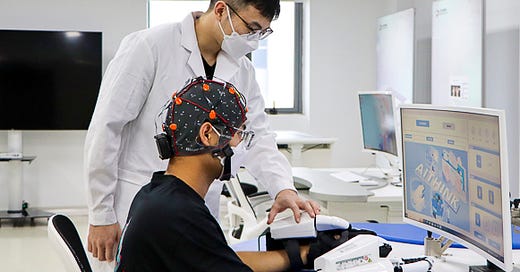PRC medtech breaks through
successes in 2025 are reshaping the future of PRC medical robotics

breakthroughs in 2025 are reshaping the future of PRC medical robotics; there's over hype, tough overseas competition, and some curly ethical headwinds
People aged 60 and above will total around 2 billion globally by 2050, projects to the WHO, with over 426 million at 80. With care for this cohort in the PRC facing a demand-supply imbalance, planning for medical robotics was a prominent topic at the March 2025 Two Sessions.
The PRC elderly care sector faces dual challenges: a shortage of care workers and constantly rising costs, warns Xu Lijin 许礼进 Wuhu Robot Industry Development Group (and CPPCC member). Mass production of humanoid robots by 2025 was urged by MIIT (Ministry of Industry and Information Technology) in 2023. Many local governments earmarked funds for related R&D.
elder care robots
The PRC aged care robotics market was worth some C¥8 bn in 2024, reports the Forward Industry Research Institute. It is projected to grow at an annual rate of 15 percent. At this rate, the market could top C¥16 bn by 2029.
Development cycles for aged care robots have meanwhile fallen by an average of 40 percent in three years. Two factors were key
a policy push on ‘intelligent’ aged care, not least ‘guiding opinions', developing industries for the elderly
large AI models applied to vast volumes of care data
Specialised robots now care for seniors in Shenzhen, Shanghai, Beijing, Hangzhou, Wuhan and Nanjing. With prices ranging from C¥20,000 to C¥100,000, current models serve three primary functions: rehabilitation, nursing, and companionship. Leading players include Estun, Midea Group, Xiangyu Medical, Ying Stone Network, and Kangtai Medical.
Intelligent assistance is replacing 20 percent to half or even more of care in some tasks, explains Zhao Chunbo 赵春波 Deyin Technology CEO. Cooperating with the Shanghai Pudong Civil Affairs Bureau, toileting care robots and self-driving wheelchairs have been tested in nursing homes for a year and a half. Companion devices are expected to be mass-produced by 2026.
little interest in real-world adoption
For all the industry enthusiasm, aged care institutions remain cautious about investing in patient repositioning robots for elderly patients in bed, notes Dang Junwu 党俊武 China Research Centre on Ageing. Basic companionship is tough for robots to emulate, and in the event of an accident, legal claims and charges become incalculable.
Robots simply fail to match human capabilities in service quality, says Dang, noting that even to hold cups for disabled seniors, care robots need at least five more years of R&D. Two to three years more are needed before they can reliably feed patients.
Simple updates in canes, walking aids and wheelchairs are leading solutions for basic elderly mobility needs globally, reports Xu Zhiyi 许之怿 an investor in the aged care industry—not flashy, humanoid robots. The PRC has limited ability to afford high-end equipment. PRC families have not yet reached a decision, Xu warns, to ‘buy or not’, let alone as to the merits of ‘good vs better’ equipment. Rather than betting on novelty, firms should focus on reducing product costs by upgrading conventional product forms with micro-tech innovations.
surgical robots
Surgical robots are more advanced than aged care devices. US firm Intuitive Surgical’s da Vinci robots have dominated the global market since 2000.
The PRC has stepped up over the past half-decade from catch-up to matching the pace of its rivals. Local startups surge in segments untapped by da Vinci, such as orthopedics, neurology and laparoscopy. Market value soared from C¥2.5 bn in 2019 to C¥6 bn in 2023. With only four approved domestic products before 2020, by 2025, there were 115.
Early integration into the PRC 5G network drove growth, enabling remote surgery and positively impacting distant and underserved regions. Such functionality is crucial for overcoming geographic, temporal and skills limitations, enthuses Cai Xiujun 蔡秀军 Sir Run Run Shaw Hospital (Hangzhou). His team performed a world-first 4,000-km liver surgery for a patient from Xinjiang via a PRC-developed 5G robot interface in 2023.
Progress has been supported by capital, highlighted by the listing of Tinavi Medical Technologies on the STAR Market in 2020. The industry completed nearly 30 financing rounds per year from 2020 to 2022.
threat from global giants gone local
Financing slowed in 2024, seeing only nine rounds. Investors have lost appetite for firms reliant on speculative potential and price wars. Reliance on imported core components suppresses domestic competitiveness.
Global giants have localised as well. A local operation for da Vinci in Shanghai was approved in June 2023, expanding in 2024. From 40 percent in H1 2024, its market share soared to 50 percent in H2.
For hospitals in the PRC, performance and quality of robots are prioritised over price. Costing over C¥20 million per unit, da Vinci devices outsold cheaper PRC alternatives in 2024.
Recovery for local manufacturers is awaited in 2025. Funding is expected to flow into the sector in the wake of a January proposal to raise ultra-long-term special bonds, together with subsequent loan interest subsidies for equipment upgrades, C¥1 tn national venture capital and the setup of a scitech bond board.
catching up with Neuralink
Brain-computer interfaces (BCIs) were designated as one of six future industries in 2024. Given the development of local BCI clusters, the sector thrived, hitting milestones in 2025.
Shanghai StairMed completed a C¥350 million B-round financing in February 2025, marking the largest single investment in the PRC implantable BCI industry.
It later showcased a first PRC clinical trial for registration of an ‘invasive’ BCI (surgically implanting electrodes or sensors directly into brain tissue) on 8 May 2025. With the subject playing computer games through thought alone, StairMed became the second firm globally to reach the clinical trial stage of such a BCI, after Elon Musk's Neuralink.
A world-first batch of flexible, high-throughput, semi-invasive, and wireless full-body BCI implants was rolled out by Beijing Brain No. 1 in March 2025. Following R&D by the Beijing Institute for Brain Research and Beijing Xinzhida Neurotechnology, a 67-year-old patient regained the ability to speak.
Trial expansion and market launch are planned for both devices. Beijing Brain No. 1 will undergo clinical trials and is expected to be approved for market release within two years. For StairMed, more patients will join a multicentre clinical trial in early 2026. The firm aims to market the device by 2029.
Health regulations have been updated to develop this sector, including
NHSA (National Healthcare Security Administration) launching new pricing items for BCI clinical adoption
NMPA (National Medical Products Administration) setting standards for AI dataset quality and evaluation, used for BCI
ethical dilemmas on mind control
Rapid BCI advances demand detailed rules, regs and standards. The safety of implants and accuracy of non-implantables are key issues, warns Pan Yunhe 潘云鹤 Chinese Academy of Engineering.
Prohibit mind-control functions in non-medical devices, urges Tsinghua University Institute for National Governance and Global Governance. ‘Mind-reading’ access to human intentions, preferences, emotions, and identities via brain signals makes BCI a threat to data security and patient privacy.
Balancing ethics and tech advances remains challenging. While strict oversight is required to ensure safety and prevent misuse, it is also vital to foster innovation, flexibility, and breakthroughs, says Luo Minmin 罗敏敏 of the Beijing Institute for Brain Research. International cooperation, agile governance, and corporate self-regulation are necessary to address safety issues in technologies like BCI, proposes Xue Lan 薛澜 Chair Professor and Director, Institute for AI International Governance, Tsinghua University.
humans talk medtech
Zhao Xiaoguang 赵晓光 CPPCC member and Chinese Academy of Sciences (CAS) Institute of Automation researcher
Elder care robots, argues Zhao, must satisfy two criteria: a smart brain and dexterous limbs. Yet they needn’t be omnicompetent or even humanoid. ‘They needn’t move on two legs—wheels may suffice; their arms don't need 27 degrees of freedom, as do humans; the 6 degrees of industrial robot arms may suffice, or indeed a single arm only.’
‘All-in-one’ functions might create problems, she adds: tech complexity, high cost, and suboptimal user experience. Expecting aged care robots to do everything is idealistic and unrealistic.
Given robots are used in specific scenarios, adds Zhao, thinking and lifestyles may need to adapt. Assembly lines have been adapted for industrial robots; humans may need to change their approach as well.
Researcher Zhao and team have built several devices, e.g. an elderly and disabled assistance, an ICU monitoring assistant, and a TCM acupuncture point recognition robot. Taking a PhD at CAS Shenyang Institute of Automation in 2001, she has worked at the CAS Institute of Automation. A member of the National CPPCC since 2023, Zhao has proposed AI integration and robotics development initiatives, which MIIT and MoST later adopted.
Kuang Shaolong 匡绍龙 Shenzhen Technology University professor
Medical/engineering merger is the primary challenge for PRC surgical robots, notes Kuang: surgeons need designs tailored to their clinical practice. Costly integrated robotic systems and the training they entail pose further hurdles.
Surgical robotics champion Kuang insists that it not only reduces physical strain and intraoperative risks but also enables minimally invasive surgery, thereby curbing trauma and speeding recovery. Remote surgery also enhances the quality of outcomes in primary-level facilities.
'Robot+' actions by localities, regional clusters in Beijing, Shanghai and Shenzhen, and prioritising human factors are key to positioning the PRC as a leading global player in surgical robotics by 2030.
A professor at Shenzhen Technology University, medical engineering expert Kuang took a PhD from Beihang University. He worked at an electronics firm in Shandong, transitioning back to academia in 2006. He works on developing medical robotic arms. As project leader and chief scientist for a key national research initiative under the 13th 5-year plan, he is regarded as an authority in surgical robotics.
Zhao Zhengtuo 赵郑拓 StairMed founder and CAS Institute of Neuroscience researcher
BCI must be clinically driven and application-oriented, argues Zhao. To seize the BCI market, installations must meet clinical standards and be practical.
Lowering patient costs and speeding standardisation and commercialisation. Recent measures signal state support
service pricing guidelines covering BCI (invasive and non-invasive)
inclusion of BCI into Shanghai’s medical insurance directory
Such policy is key, argues Zhao, to making R&D accessible. PRC firms must define technical standards via valuable, market-ready products.
A PhD in Biomedical Engineering from the University of Texas at Austin (2015), Zhao founded StairMed. He is a researcher, principal investigator there, and PhD supervisor at the Centre for Excellence in Brain Science and Intelligence Technology, Chinese Academy of Sciences.
If you are overwhelmed by emails—use the app it’s way better!








